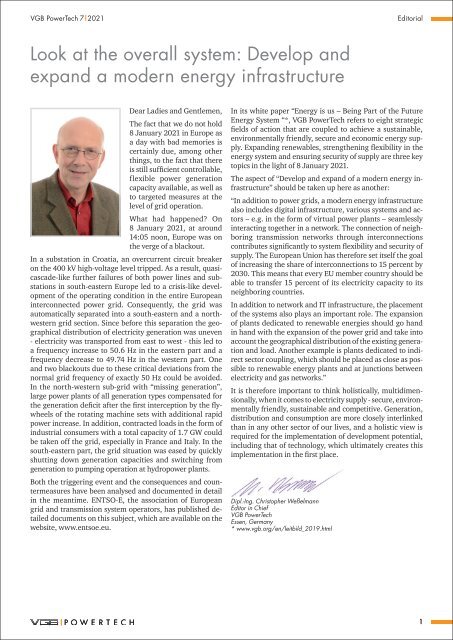VGB POWERTECH 7 (2021) - International Journal for Generation and Storage of Electricity and Heat
VGB PowerTech - International Journal for Generation and Storage of Electricity and Heat. Issue 7 (2021). Technical Journal of the VGB PowerTech Association. Energy is us! Optimisation of power plants. Thermal waste utilisation.
VGB PowerTech - International Journal for Generation and Storage of Electricity and Heat. Issue 7 (2021).
Technical Journal of the VGB PowerTech Association. Energy is us!
Optimisation of power plants. Thermal waste utilisation.
- No tags were found...
You also want an ePaper? Increase the reach of your titles
YUMPU automatically turns print PDFs into web optimized ePapers that Google loves.
<strong>VGB</strong> PowerTech 7 l <strong>2021</strong><br />
Editorial<br />
Look at the overall system: Develop <strong>and</strong><br />
exp<strong>and</strong> a modern energy infrastructure<br />
Dear Ladies <strong>and</strong> Gentlemen,<br />
The fact that we do not hold<br />
8 January <strong>2021</strong> in Europe as<br />
a day with bad memories is<br />
certainly due, among other<br />
things, to the fact that there<br />
is still sufficient controllable,<br />
flexible power generation<br />
capacity available, as well as<br />
to targeted measures at the<br />
level <strong>of</strong> grid operation.<br />
What had happened? On<br />
8 January <strong>2021</strong>, at around<br />
14:05 noon, Europe was on<br />
the verge <strong>of</strong> a blackout.<br />
In a substation in Croatia, an overcurrent circuit breaker<br />
on the 400 kV high-voltage level tripped. As a result, quasicascade-like<br />
further failures <strong>of</strong> both power lines <strong>and</strong> substations<br />
in south-eastern Europe led to a crisis-like development<br />
<strong>of</strong> the operating condition in the entire European<br />
interconnected power grid. Consequently, the grid was<br />
automatically separated into a south-eastern <strong>and</strong> a northwestern<br />
grid section. Since be<strong>for</strong>e this separation the geographical<br />
distribution <strong>of</strong> electricity generation was uneven<br />
- electricity was transported from east to west - this led to<br />
a frequency increase to 50.6 Hz in the eastern part <strong>and</strong> a<br />
frequency decrease to 49.74 Hz in the western part. One<br />
<strong>and</strong> two blackouts due to these critical deviations from the<br />
normal grid frequency <strong>of</strong> exactly 50 Hz could be avoided.<br />
In the north-western sub-grid with “missing generation”,<br />
large power plants <strong>of</strong> all generation types compensated <strong>for</strong><br />
the generation deficit after the first interception by the flywheels<br />
<strong>of</strong> the rotating machine sets with additional rapid<br />
power increase. In addition, contracted loads in the <strong>for</strong>m <strong>of</strong><br />
industrial consumers with a total capacity <strong>of</strong> 1.7 GW could<br />
be taken <strong>of</strong>f the grid, especially in France <strong>and</strong> Italy. In the<br />
south-eastern part, the grid situation was eased by quickly<br />
shutting down generation capacities <strong>and</strong> switching from<br />
generation to pumping operation at hydropower plants.<br />
Both the triggering event <strong>and</strong> the consequences <strong>and</strong> countermeasures<br />
have been analysed <strong>and</strong> documented in detail<br />
in the meantime. ENTSO-E, the association <strong>of</strong> European<br />
grid <strong>and</strong> transmission system operators, has published detailed<br />
documents on this subject, which are available on the<br />
website, www.entsoe.eu.<br />
In its white paper “Energy is us – Being Part <strong>of</strong> the Future<br />
Energy System “*, <strong>VGB</strong> PowerTech refers to eight strategic<br />
fields <strong>of</strong> action that are coupled to achieve a sustainable,<br />
environmentally friendly, secure <strong>and</strong> economic energy supply.<br />
Exp<strong>and</strong>ing renewables, strengthening flexibility in the<br />
energy system <strong>and</strong> ensuring security <strong>of</strong> supply are three key<br />
topics in the light <strong>of</strong> 8 January <strong>2021</strong>.<br />
The aspect <strong>of</strong> “Develop <strong>and</strong> exp<strong>and</strong> <strong>of</strong> a modern energy infrastructure”<br />
should be taken up here as another:<br />
“In addition to power grids, a modern energy infrastructure<br />
also includes digital infrastructure, various systems <strong>and</strong> actors<br />
– e.g. in the <strong>for</strong>m <strong>of</strong> virtual power plants – seamlessly<br />
interacting together in a network. The connection <strong>of</strong> neighboring<br />
transmission networks through interconnections<br />
contributes significantly to system flexibility <strong>and</strong> security <strong>of</strong><br />
supply. The European Union has there<strong>for</strong>e set itself the goal<br />
<strong>of</strong> increasing the share <strong>of</strong> interconnections to 15 percent by<br />
2030. This means that every EU member country should be<br />
able to transfer 15 percent <strong>of</strong> its electricity capacity to its<br />
neighboring countries.<br />
In addition to network <strong>and</strong> IT infrastructure, the placement<br />
<strong>of</strong> the systems also plays an important role. The expansion<br />
<strong>of</strong> plants dedicated to renewable energies should go h<strong>and</strong><br />
in h<strong>and</strong> with the expansion <strong>of</strong> the power grid <strong>and</strong> take into<br />
account the geographical distribution <strong>of</strong> the existing generation<br />
<strong>and</strong> load. Another example is plants dedicated to indirect<br />
sector coupling, which should be placed as close as possible<br />
to renewable energy plants <strong>and</strong> at junctions between<br />
electricity <strong>and</strong> gas networks.”<br />
It is there<strong>for</strong>e important to think holistically, multidimensionally,<br />
when it comes to electricity supply - secure, environmentally<br />
friendly, sustainable <strong>and</strong> competitive. <strong>Generation</strong>,<br />
distribution <strong>and</strong> consumption are more closely interlinked<br />
than in any other sector <strong>of</strong> our lives, <strong>and</strong> a holistic view is<br />
required <strong>for</strong> the implementation <strong>of</strong> development potential,<br />
including that <strong>of</strong> technology, which ultimately creates this<br />
implementation in the first place.<br />
Dipl.-Ing. Christopher Weßelmann<br />
Editor in Chief<br />
<strong>VGB</strong> PowerTech<br />
Essen, Germany<br />
* www.vgb.org/en/leitbild_2019.html<br />
1


















